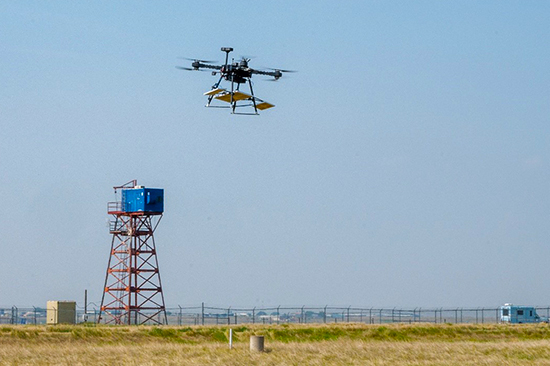Remote Threat Detection: DRDC tests the limits of sensors on drones in NATO trial
June 14, 2023 - Defence Stories

Caption
A drone flies over a field during the trials.
Credit: Mike Franz / DRDC
A convoy of military vehicles idles on a dusty road, as the sun bakes down. Soldiers look on as a black dot in the blue sky sprouts propellers and becomes recognizable as a quad-copter drone, accompanied by a high-pitched humming as it approaches. Sensors mounted on the drone are scanning the road in front of the convoy for hazards including improvised explosive devices (IEDs). The all-clear is given and the convoy moves on safely.
This scenario sounds like a scene from a Hollywood movie, but the tech behind is being tested in a real-world field trial hosted by Defence R&D Canada – Suffield Research Centre (DRDC SRC) in support of the NATO Science and Technology Office (STO) at Canadian Forces Base Suffield this week from June 12 to 15, 2023.
In a military setting, advance sensors mounted on drones offer a chance to detect not only what’s immediately visible, but also what’s buried, camouflaged, or hidden behind objects such as on a rooftop or a bridge, all from a safe distance. The NATO STO Research Task Group SCI-321 set out to assess the technology readiness, potential, limitations, and remaining development challenges for the use of small drones — also known as Uncrewed Aerial Vehicles (UAV) — for the detection of targets during Military Search operations. NATO SCI-321 held a previous trial in Spain in 2021, generating many useful observations. A second trial is being held in North America in order to get broader visibility on the state-of-the-art sensors and systems being development for these missions.
“The capability to be able to search remotely using the most advanced platforms and sensors is intended to make safer for Canadian Armed Forces members, and our Allies, to go into potentially dangerous situations and accomplish their missions more efficiently,” said defence scientist Dr. Anthony Faust, who is the head of the Threat Mitigation Group at DRDC SRC and appointed Canadian representative to NATO SCI-321. “The whole DRDC Counter Explosive Threat S&T community is continuously looking for new sensors and effectors, and ways of employing them, in order to improve Canadian Armed Forces’ capability through the exploitation of advanced technologies. This collaboration with NATO allies allows us to validate this technology collectively, promotes interoperability between NATO members, and supports building next-generation CAF capabilities for the soldiers who are putting their lives on the line.”
Dr. Faust and Captain Michael Tholl, RCE, a Staff Officer in the Military Engineering Section at DRDC SRC, lead the trial planning on behalf of DRDC, working with NATO and over 60 visiting international personnel in eight teams from eight NATO and Enhance Opportunity Partner countries including Canada, Germany, France, the Netherlands, Norway, Sweden, UK, and the US. Together, they put drones through a variety of Military Search scenarios to assess the readiness and limitations of the technology.
CFB Suffield offered a unique testing location where it was possible to set up realistic scenarios, including area search with unexploded ordnance and scatterable landmine threats, infrastructure search at heights, and many kilometers of route search in order to ensure a convoy of military vehicles can pass through. Additionally, the prairie spring weather offers additional variables such as high wind and precipitation that will test the operational limitations of the platforms.
“The trial scenarios were identified as being representative of a number of search tasks our soldiers are asked to perform,” said Maj Peter DesRoches, Army Directorate Land Requirements, Ottawa, who is Project Director for future Counter Explosive Threat capabilities and one of the Army sponsors of DRDC’s Counter Explosive Threat S&T program. “CAF envisions the future use of drone platforms in missions, and trials such as this put the sensors through rigorous testing, allowing us to better understand their current capabilities and future potential, getting us that much closer to technology that truly keeps our members safe.”
While the wide availability of modern drone platforms is the result of popular demand across the recreational, industrial, and military communities, the development of Military Search-specific sensors is much more specialized and has largely been driven by defence requirements and lead by defence scientists at DRDC its allied equivalents, with the support of industry and academics. In addition to the more well known broadband visible and Thermal infrared (IR) optics, the sensors being demonstrated at the NATO trial include: multispectral visible, near infrared (IR), and longwave Thermal optics; ground penetrating radar; synthetic aperture radar; electronics detection; and, LiDaR.
Results from the trial will be analyzed and reported by NATO SCI-321 team, and will aide nations in identifying outstanding capability development issues that are limiting the full exploitation of small UAVs for these military tasks, thereby informing future investment and capability development plans.
Supporting and leading international trials such as this helps DRDC accomplish its goals of providing risk mitigation to the development and implementation of advanced technologies for the CAF, all while enabling interoperability between allies.
“DRDC regularly conducts fundamental and applied research, developing and testing prototypes of advanced technologies,” said Dr. Faust. “We are bringing technologies and innovations out of testing labs and into real-world military applications.”